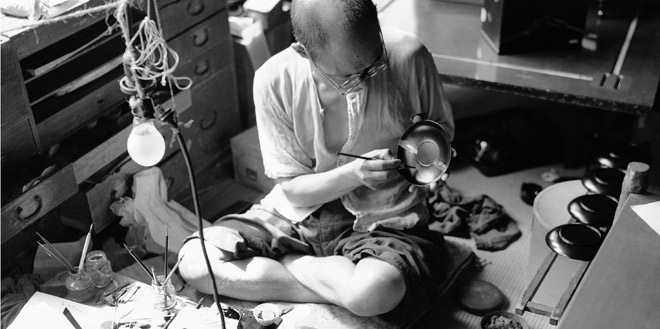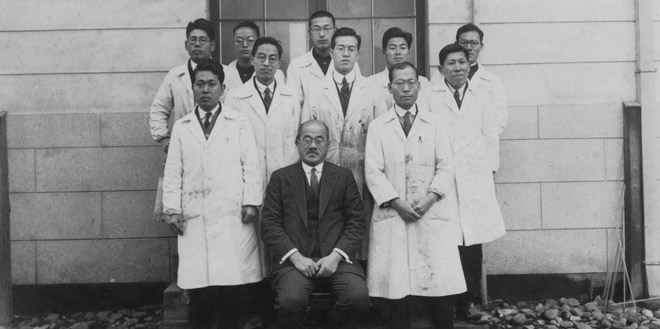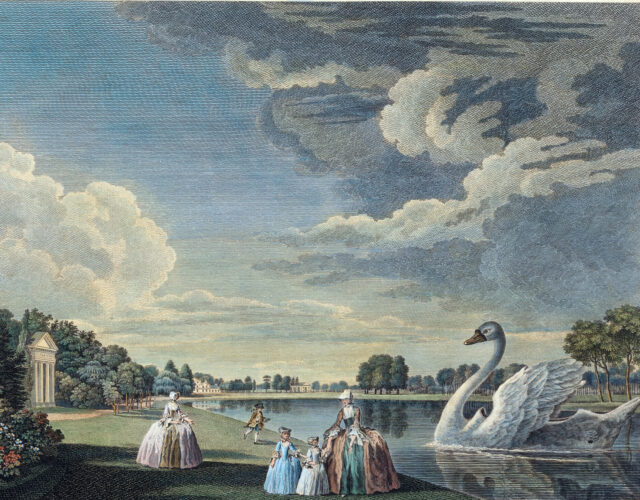One October day in 1784 Philadelphia horticulturalist William Bartram wrote out a list of 220 “American Trees, Shrubs, & herbs” in his fine, flowing handwriting. He was packing up seeds and young plants to send across the Atlantic, as he had many times before. European collectors were eager to buy New World trees and plants, whether useful, ornamental, or simply unusual. Bartram’s shipment included 12 oak species, 9 different pines, and 3 kinds of plums, along with such flowering plants as sunflowers and morning glories. Numbers 114 and 120 on the list, bracketing 5 varieties of grapes, were a bit different: “Rhus vernix” and “Rhus radicans,” known to us today as poison sumac and poison ivy.
It may seem incredible that Bartram offered these noxious plants for sale and that people in Europe actually bought them. For most people poison ivy has long meant just one thing: suffering. The common three-leaved plant and its relatives—poison oak and poison sumac, found in North America, and the lacquer tree, native to Asia—all contain urushiol, an organic compound that sets off violent allergic reactions in most humans. But as Bartram’s packing list suggests, there is more to these plants than the painful, itchy rashes they cause. Over the centuries intrepid botanists, daring physicians, master craftsmen, and persistent chemists have looked for the good side of poisonous plants. These vines, shrubs, and trees have been collected as exotic garden curiosities, have been sourced for medicine that might cure rather than harm, and have been harvested for the sticky sap that gives lacquerware its sheen.
The Poisoned Weeds
In 1624 explorer John Smith published the first written account of poison ivy, basing it on an unpublished manuscript by Nathaniel Butler, who learned about the plant while governor of Bermuda. Smith’s brief description neatly summarizes the plant’s appearance and irritant effects: “The poisoned weed is much in shape like our English Ivy, but being but touched, causeth rednesse, itching, and lastly blisters.”
Both men, however, went on to defend the plant. Since the blisters, in Smith’s words, “after a while passe away of themselves without further harme, yet because for the time they are somewhat painfull, [the plant] hath got it selfe an ill name, although questionlesse of no ill nature.” The writers evidently felt that a temporary rash was not enough to brand the plant as “poison,” but the nickname stuck. Later authors would always warn of poison ivy’s dangers, though only a few intrepid souls would pick up on Butler’s and Smith’s suggestion that it and countless other New World plants had the potential for “many usefull employments, which time and industry no doubt will one day discover.”
Over the centuries intrepid botanists, daring physicians, master craftsmen, and persistent chemists have looked for the good side of poisonous plants.
For the next several decades poison ivy remained an exotic oddity, just one of the thousands of new and interesting plants found in the Americas. By 1640 travelers and settlers had gathered the plant or its seed-containing berries in the wild—cautiously, one presumes—and sent them to Europe to be cultivated in the English royal gardens at Kew, the gardens of the Faculty of Medicine in Paris, and a few other locations. Botanists noted the plant’s properties and published it with names that reflected its appearance and North American origins, such as Edera trifolia canadensis and Hedera trifolia virginiensis (trefoil or three-leaved ivy of Canada or Virginia), sometimes with illustrations showing its leaves, roots, and berries.
By 1804 both poison ivy and poison sumac (perhaps descendants of the plants William Bartram sent to Europe in the 1780s) were flourishing near Paris in the gardens of Empress Joséphine Bonaparte, who was an avid amateur botanist and plant collector. Renowned flower artist Pierre-Joseph Redouté, famed for his gorgeous depictions of roses and lilies, even drew a poison ivy plant with its berries for a luxury publication on native and imported trees and shrubs cultivated in France. Though known to some elite botanists in Great Britain and Continental Europe, poison ivy never became truly popular since its attractive appearance could not outweigh its noxious powers. As the authors of the book illustrated by Redouté recommended, the plant and its relatives were best “kept away from ornamental gardens and relegated to those of the curious.”
These poisonous plants also intrigued medical practitioners. Accounts of experiments with poison ivy as a medicine are scattered throughout 18th- and 19th-century scientific and medical publications. At a time when nearly all medicines came from plants and being a physician or pharmacist required a working knowledge of botany, it was logical to assume that a plant with such a strong effect on the body had the potential for healing.
André-Ignace-Joseph Dufresnoy, an army physician and medical professor from Valenciennes in northern France, became one of poison ivy’s most fervent supporters around 1780. Like many physician-botanists of the era, he collected unusual plants for his personal medicinal garden. He also gave botany lectures that were open to the general public. One day Dufresnoy showed some leaves of his “Rhus-Radicans” and spoke about its irritant effects. A young florist in the audience could not believe that such an innocent-looking plant could be so powerful. After the lecture he rubbed the leaves vigorously in his hands, egged on by one of Dufresnoy’s students. The florist soon regretted his impulsive act, but after the painful swelling and rash finally cleared, he came to tell the physician that an ugly old sore on his wrist had completely vanished.
Dufresnoy was thrilled with this apparent miracle cure and immediately began concocting medicines from poison ivy. To avoid causing rashes in his patients he boiled poison ivy leaves to make an infusion for internal use, first drinking it himself as a test. He reported that even a strong infusion made with 12 leaves produced only mild side effects: his stomach became slightly upset and his sweating and urination increased. He then prescribed the infusion, and later a distilled extract from his poison ivy plants, to people suffering a range of skin maladies and even to some with paralysis of the legs, claiming positive results in many cases.
During the French Revolution, Dufresnoy’s fondness for poison ivy nearly sent him to the guillotine.
During the French Revolution, Dufresnoy’s fondness for poison ivy nearly sent him to the guillotine. After sending some young plants from his garden to a physician friend, he wrote in 1794 to ask, “How are our dear Rhus? How I long to see them!” The letter was intercepted and Dufresnoy was arrested on suspicion of conspiring with the Russians (Russes in French), who were then threatening to join the wartime coalition against France. Fortunately, the political upheaval that ended the Reign of Terror also deposed the harsh judge who was about to hear his case, and Dufresnoy was able to explain to the authorities that “dear Rhus” referred to medicinal plants, not menacing foreign troops. After this lucky escape the doctor’s story has a poignant ending. Following his death in 1801 his skeptical pharmacist brother dug up and destroyed all the poison ivy plants in his garden. Dufresnoy would certainly have been saddened to see his lovingly tended Rhus plants ripped out like noxious weeds.
A Fine Coat
Dufresnoy’s dream of poison ivy as a panacea remained unfulfilled, but one of the plant’s relatives proved very useful—though not in a health context. Just like its American relatives, the Chinese lacquer or varnish tree (Toxicodendron vernicifluum) produces a sticky sap that can cause a virulent rash. Since prehistoric times the Chinese have collected and refined this sap to coat wooden and metal objects, and its use in Korea and Japan also goes back many centuries.

Though Europeans had their own plant-based varnishes made from such resin-rich trees as pines and balsams, they were impressed with the strength, resilience, and beauty of Asian lacquerware. In the 1880s German geographer Johannes Justus Rein, one of the first Westerners to study the lacquer-making process in detail, described how Japanese workers made parallel incisions on tree trunks and used shells to collect the sap, then carefully refined and aged the sap into multiple grades of lacquer for different uses. In the course of his research he contracted lacquer poisoning (urushi-kabure in Japanese) and described the symptoms:
While exposure to raw sap and the purified liquid could cause lacquer poisoning, the varnish became harmless once it dried thoroughly. Lacquer coated everything from ordinary dishes to fine artistic creations embellished with pigments, gold, silver, and mother-of-pearl. Master craftsmen also built up thin layers of lacquer on wooden containers, and then carved it in elaborate floral and geometric patterns. Such decorative Chinese and Japanese lacquerware, exported in large quantities, became very popular in the West. During the 19th century Europeans even produced imitation lacquerware by “japanning” items with black varnish and gold paint, though such copies could not compare to the genuine articles.
An Oily Tale
In the 20th century botanists began to reclassify the poisonous plants. Poison ivy, poison oak, and poison sumac were originally placed in the genus Rhus (the sumacs). By the 1930s botanists often separated the irritating plants from the other sumacs, assigning them to the appropriately named genus Toxicodendron (Greek for “poison tree”). There are two species of poison ivy: T. radicans (formerly Rhus toxicodendron or Rhus radicans), the familiar trailing or climbing vine that is widespread in the United States and Canada east of the Rocky Mountains, and T. rydbergii (nonclimbing poison ivy), a shrub found throughout North America except in the southeastern states. The two species of poison oak—T. pubescens, or Atlantic poison oak, and T. diversilobum, western or Pacific poison oak—earn their common name from their oak-shaped leaves. Poison sumac (T. vernix), an eastern swamp-dwelling shrub or small tree, is far more toxic than its relatives.
Given the long history of the toxicodendrons as health hazards and their economic role in making lacquer, chemists soon became interested in isolating their noxious compounds. Because smoke from burning plants can cause allergic reactions, even inside the lungs, many believed the active ingredient was a volatile oil that the plants exuded into the air. Chemists soon abandoned that idea and instead wrongly identified the toxin as a carbohydrate (that is, a sugar).
The chemist who finally got it right, identifying and characterizing urushiol as the key irritant, was from Japan, appropriately enough. Rikō Majima was among the first Japanese scientists to receive most of his education in his home country following the end of sakoku, Japan’s 200-year period of isolationism. Sakoku had left Japan far behind the West in terms of science and innovation. In order to compete with Western chemists Majima focused his research on local natural products, studying the lacquer tree from 1907 to 1922. Building on previous work by Japanese and Western scientists, he collected sap from a lacquer tree on a nearby plantation and extracted the toxin and other components with alcohol. After a series of filtrations, distillations, and extractions he obtained a sample of the allergic substance pure enough for chemical analysis. His dermatologist colleague Ikuzo Toyama then tested the samples, presumably on himself and courageous volunteers. For his next steps Majima turned to modern analytical methods and instrumentation imported from the West, such as ozonolysis, which used ozone produced by running high-voltage electricity through purified oxygen to systematically break down organic compounds. He eventually established the exact chemical structure of the toxin, which he named urushiol after urushi, the Japanese word for lacquer.

Majima found that urushiol is not a single substance but rather a mixture of closely related compounds known as alkyl catechols. These elongated molecules have a head containing a ringed structure (the catechol) and a long, greasy, water-repellent tail of either 15 or 17 carbon atoms (the alkyl chain). Catechols are common in nature and include such familiar molecules as adrenaline and dopamine. The greasy alkyl chain allows urushiol to penetrate skin and to remain on clothing and other surfaces for months or even years. Once inside the skin oxygen activates the catechol head, which links up with skin proteins. White blood cells recognize these urushiol-studded proteins as invaders and activate the body’s immune defenses, causing the familiar and painful rash, blisters, and itching. Little can be done to stop the allergic response once it begins, although immunosuppressive drugs, such as cortisone or prednisone, can help. Applying hot water or calamine lotion provides only partial relief.
The study of these intriguing molecules continues. In 2012 researchers at the University of California, Santa Cruz, engineered a molecule that reacts with urushiol to form a fluorescent compound, allowing even minute amounts of urushiol to be detected with ultraviolet light—perhaps a future boon to hikers and campers.
Best in Show
One California community has learned to “celebrate” poisonous plants, using humor to deal with a persistent nuisance. The Annual Poison Oak Show in Columbia, a historic mining town in the foothills of the Sierra Nevada mountains, began in 1982. The festival includes flower show–type competitions for the best poison oak arrangements (displayed behind yellow caution tape), for “Most Potent Looking” red and green leaves, for best poison oak jewelry and accessories, and even for the best photograph of a poison oak rash. As a local floral designer noted dryly in 2007, “It would be a great fall accent—if you could use it. The trouble is, you couldn’t count on re-orders.”
Finally, a few brave and patient horticulturists in Japan and the United States use poison ivy in a unique way, training the plants into bonsai, miniature trees in containers. With shiny green leaves that turn a brilliant red in the fall, thick woody stems, and pale green-white flowers, these poison ivy bonsai are as lovely as the maples and junipers more commonly made into tiny trees. Their owners would surely agree with Captain Smith and Governor Butler that even “a poysoned weed” has “no ill nature.”
An Ocean of Calamine Lotion
Many flowers have been celebrated in popular songs—the ever-romantic rose, the fragrant orange blossom, even the dainty buttercup. Poison ivy seems to be an unlikely candidate for this pantheon, but the rash-inducing plant has a minor yet enduring place in pop music, thanks to a hit song first recorded by the rhythm-and-blues group the Coasters in 1959. Its creators, lyricist Jerry Leiber and composer Mike Stoller, are famed for the Elvis Presley tunes “Hound Dog” and “Jailhouse Rock” and for cowriting the classic ballad “Stand by Me” with singer Ben E. King.
Set to a peppy beat with a wailing chorus, the clever lyrics of “Poison Ivy” describe a woman who seems at first to be like a flower: “She comes on like a rose” and is “pretty as a daisy,” but will “really do you in / if you let her get under your skin.” The effects of other diseases cannot compare.
As Leiber later recalled, “Pure and simple, ‘Poison Ivy’ is a metaphor for a sexually transmitted disease—or the clap [gonorrhea]—hardly a topic for a song that hit the Top Ten in the spring of 1959. But the more we wrote, the less we understood why the public bought what it bought. It didn’t make sense, but it didn’t matter. We were having fun.”
The song’s sexual overtones may have enhanced its popularity. More than a dozen different musicians or groups have recorded the tune, including the Dave Clark Five, the Rolling Stones, Manfred Mann, Linda McCartney, and the 1990s boy band Hanson. A version by pioneering Australian pop group Billy Thorpe and the Aztecs even “out-Beatled the Beatles” (as a Sydney television host put it), topping the national charts in June 1964 during the Fab Four’s only tour of that country.
The plant has lent its name to several other pop songs; to a 1992 movie thriller about a murderous teen (with the tagline “What Ivy wants, Ivy gets”) and its erotic sequels; to the lead guitarist of the punk-rock group the Cramps; and perhaps most famously to the sexy super-villainess of the Batman comics, whose alter ego is a brilliant botanist and who uses plant pheromones and toxins to hypnotize, seduce, and kill her enemies. Poison ivy’s association with alluring yet dangerous femininity will undoubtedly continue to twine through popular culture.
The authors would like to thank Michael Gross, Joel T. Fry, and Anne Boyd.
In an earlier version of this article, we incorrectly transliterated Rikō Majima’s name. We regret this error.




